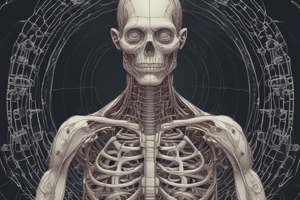Podcast
Questions and Answers
Which type of tissue is primarily responsible for supporting and binding other tissues in the body?
Which type of tissue is primarily responsible for supporting and binding other tissues in the body?
- Nervous Tissue
- Muscle Tissue
- Epithelial Tissue
- Connective Tissue (correct)
What is the primary role of the lungs in the human body?
What is the primary role of the lungs in the human body?
- Facilitating gas exchange (correct)
- Pumping blood to various organs
- Filtering blood and creating urine
- Metabolizing nutrients
Which physiological concept describes the body's ability to maintain a stable internal environment?
Which physiological concept describes the body's ability to maintain a stable internal environment?
- Homeostasis (correct)
- Tissue Repair
- Cellular Respiration
- Metabolism
What are the components of tissue repair mechanisms?
What are the components of tissue repair mechanisms?
What is the overall function of the heart in the human body?
What is the overall function of the heart in the human body?
Which level of organization is characterized by groups of similar cells performing a specific function?
Which level of organization is characterized by groups of similar cells performing a specific function?
Which body system is primarily responsible for regulating temperature and protecting the body?
Which body system is primarily responsible for regulating temperature and protecting the body?
What is the primary role of the cardiovascular system?
What is the primary role of the cardiovascular system?
Which type of feedback mechanism in homeostasis enhances changes rather than restoring balance?
Which type of feedback mechanism in homeostasis enhances changes rather than restoring balance?
Which of the following correctly describes the primary function of the nucleus in a cell?
Which of the following correctly describes the primary function of the nucleus in a cell?
What is the fundamental role of organelles within a cell?
What is the fundamental role of organelles within a cell?
What defines the organism level in the hierarchy of biological organization?
What defines the organism level in the hierarchy of biological organization?
Which tissue type is responsible for covering body surfaces and protecting underlying structures?
Which tissue type is responsible for covering body surfaces and protecting underlying structures?
Study Notes
Introduction to Anatomy and Physiology
- Anatomy: Study of the structure of body parts and their relationships.
- Physiology: Study of the function of body parts and how they work together.
Levels of Organization
- Chemical Level: Atoms and molecules (e.g., DNA, proteins).
- Cellular Level: Cells, the basic unit of life (e.g., muscle cells, nerve cells).
- Tissue Level: Groups of similar cells performing a specific function (e.g., epithelial, connective, muscle, nervous).
- Organ Level: Structures made up of two or more different types of tissues (e.g., heart, lungs).
- Organ System Level: Groups of organs that work together (e.g., respiratory system, digestive system).
- Organism Level: The complete living entity that can function independently.
Body Systems
- Integumentary System: Protects body, regulates temperature (e.g., skin, hair, nails).
- Skeletal System: Supports body, protects organs, facilitates movement (e.g., bones, cartilage).
- Muscular System: Enables movement, maintains posture (e.g., skeletal muscles).
- Nervous System: Responds to internal and external changes (e.g., brain, spinal cord).
- Endocrine System: Secretes hormones for regulation (e.g., glands, pancreas).
- Cardiovascular System: Transports nutrients and oxygen (e.g., heart, blood vessels).
- Lymphatic System: Maintains fluid balance, immune response (e.g., lymph nodes, spleen).
- Respiratory System: Supplies oxygen, removes carbon dioxide (e.g., lungs, trachea).
- Digestive System: Breaks down food for energy (e.g., stomach, intestines).
- Urinary System: Eliminates waste, regulates fluids (e.g., kidneys, bladder).
- Reproductive System: Produces offspring (e.g., ovaries, testes).
Homeostasis
- Definition: The body’s ability to maintain stable internal conditions despite external changes.
- Key processes: Feedback mechanisms, including:
- Negative Feedback: Restores balance (e.g., regulating body temperature).
- Positive Feedback: Enhances change (e.g., blood clotting).
Basic Cell Structure
- Cell Membrane: Semi-permeable barrier; controls entry/exit.
- Cytoplasm: Fluid inside the cell where organelles are located.
- Nucleus: Contains genetic material (DNA); controls cell functions.
- Organelles: Specialized structures (e.g., mitochondria for energy, ribosomes for protein synthesis).
Tissue Types
- Epithelial Tissue: Covers body surfaces, and lines cavities (e.g., skin epithelium).
- Connective Tissue: Supports, binds other tissues (e.g., bone, blood).
- Muscle Tissue: Facilitates movement (e.g., skeletal, cardiac, smooth).
- Nervous Tissue: Transmits impulses (e.g., neurons, glial cells).
Important Physiological Concepts
- Metabolism: All chemical reactions in the body (catabolism and anabolism).
- Homeostasis Maintenance Mechanisms: Sensors, control center, effector responses.
- Tissue Repair Mechanisms: Inflammatory response, regeneration, fibrosis.
Overview of Organ Functions
- Heart: Pumps blood throughout the body.
- Lungs: Facilitate gas exchange (O2/CO2).
- Kidneys: Filter blood, create urine.
- Liver: Metabolizes nutrients, detoxifies toxins.
Conclusion
- Anatomy and physiology are interrelated fields essential for understanding how the human body functions and maintains health. Understanding these concepts provides a foundation for more advanced studies in medical and biological sciences.
Studying That Suits You
Use AI to generate personalized quizzes and flashcards to suit your learning preferences.
Description
This quiz covers the fundamental concepts of anatomy and physiology, including the levels of organization within the human body. Explore various body systems and understand their structure and function, from the chemical level to the organism level.




